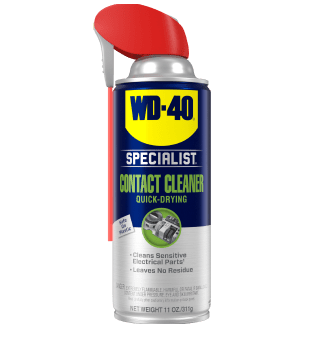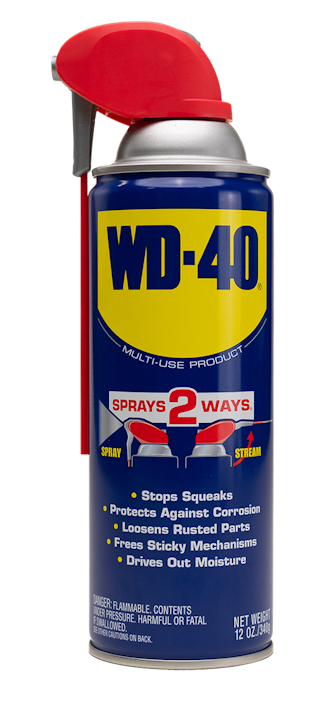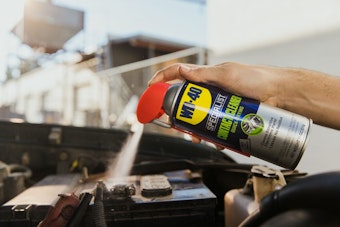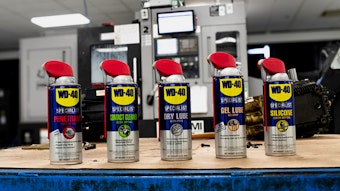Using Electrical Contact Cleaner: Tips for Various Applications
Using Electrical Contact Cleaner: Tips for Various Applications
<< BackAn electrical contact cleaner is a specialized product designed to clean typical electrical contact metals, like copper and brass, found in industrial and commercial settings. Its cleaning power can help you remove a wide range of contaminants including greases, oils, dirt, oxidation and carbon deposits.
When it comes down to it, the right electrical contact cleaner like WD-40 Specialist® Contact Cleaner can prevent degradation, remove dirt, and help your electronics keep up their original performance.
In the piece below, we will delve into the inner workings of electrical contact cleaners and how to select the right one. In addition, we will look at common application techniques and discuss the best maintenance and reapplication practices to follow.
Without further ado, let’s start zapping those contacts clean!
Understanding Electrical Contact Cleaner
Electrical contact cleaner, also known as electrical cleaner or contact cleaning solution, is a product specifically formulated to clean electrical components in industrial and commercial settings. Its formulation enables it to remove oil, dirt, flux residue and condensation from sensitive electronics and electrical equipment.
Since these solutions are formulated to work with electrical components, they are more efficient in cleaning electrical equipment than general-purpose cleaners. Electrical contact cleaners are also a safer alternative to general-purpose cleaners as most of them contain solvents that evaporate quickly, reducing potential exposure time. Common solvents include isopropyl alcohol, heptane, acetone and synthesized solvents like isoparaffinic hydrocarbon. The evaporative properties of these solvents ensure they do not damage sensitive components or leave conductive residues after cleaning.
There are many benefits associated with the regular use of an electrical contact cleaner, like reducing wear and tear on the components and enhancing electrical conductivity and performance. Let's unpack these benefits in more detail:
Reducing Wear and Tear
Dirt creates an abrasive surface that causes increased friction, degrading the contact surfaces over time. This ultimately leads to poor connectivity and reduced efficiency. Regular use of an electrical contact cleaner helps minimize the wear and tear experienced by electrical components like connectors, switches, and relays by removing contaminants like dirt and oil, thereby prolonging their lifespan.
Enhancing Electrical Conductivity and Performance
By removing contaminants, electrical contact cleaners enhance the conductivity of connections. The conductivity enhancement is thanks to a better connection between the electrical connections. This leads to improved performance like better signal or electrical transfer and a more reliable electrical system.
Watch how WD-40 Specialist® Contact Cleaner is used in applications like cleaning an industrial battery or electric tools.
Selecting the Right Electrical Contact Cleaner
Now that we better understand the benefits of using an electrical contact cleaner, the natural next question becomes: how does one go about choosing from the various options available?
Electrical contact cleaners can typically be grouped into three groups:
- Solvent-based Electrical Cleaners: These cleaners are highly effective at removing grease, oil and other contaminants but can be flammable and require careful handling. Solvents typically used include heptane, isopropyl alcohol and acetone.
- Water-based Electrical Cleaners: These electrical cleaners are less hazardous than their solvent-based counterparts. However, being less hazardous comes at the price of typically being less effective on heavy contaminants. Examples of water-based cleaners include deionized water mixed with mild detergents or surfactants. If water-based cleaners are used, it is of paramount importance to ensure the electrical equipment dries completely. Failure to do so can lead to short circuits and equipment failure.
- Non-flammable Electrical Cleaners: These contact cleaning solutions are ideal for high-voltage applications. They are typically specialized formulations and require special handling and safety precautions. Typical non-flammable cleaners consist of fluorinated solvents or hydrofluoroethers (HFEs). These cleaners evaporate rapidly, leave minimal residue and are effective at removing a wide range of contaminants, including oils and greases.
Choosing the correct cleaner may seem intimidating, but that’s where our list comes into play. When choosing an electrical contact cleaner there are various factors to consider, including:
Application Environment
Consider the environment where the contact cleaning solution will be used. Environmental factors to bear in mind include temperature and humidity. Toxicity must also be taken into account. In well-ventilated environments, toxic chemicals pose a lower risk than in environments with less ventilation. Check the material safety data sheet (MSDS) for information on exposure thresholds and types of exposure (inhalation, swallowing) that could be hazardous.
Material Compatibility
Ensure the cleaner is compatible with the materials of the electrical system to avoid damage. Electrical circuits often include plastic or rubber parts for mounting or sealing. Test the cleaner on a small area to ensure it does not react negatively.
WD-40 Specialist® Contact Cleaner is safe to use on electrical equipment and most plastics and metal parts.*
Specific Requirements of the Electrical System
Consider any specific needs of the electrical system like the need for rapid evaporation. Rapid evaporation allows quicker downtime in operations and may prove valuable on more than one front. Also, do not forget unique elements like sensitivity to certain chemicals and flammability. Ensure the cleaner does not contain any chemicals that may damage your system. Understanding the flammability of the cleaner will further assist you in ensuring safe usage, look for the cleaner's flash point in its MSDS. The flash point is the lowest temperature at which the vapors from the cleaner can ignite. Always consult the MSDS for detailed safety information.
If you are looking for a powerful contact cleaner that removes 95% of common surface contaminants**, WD-40 Specialist® Contact Cleaner is the way to go. Find it at a retailer near you.
Turn Your Electrical Contact Cleaner into a Safe Cleaner
When using an electrical contact cleaner like WD-40 Specialist Contact Cleaner, it is very important to follow the directions provided by the manufacturer and to ensure you wear the appropriate personal protective equipment (PPE). Below we will look at how to prepare the surface for application, what proper application techniques to follow, and common mistakes you should avoid.
Preparing the Surface for Safe Application
Before application, shut off all power and make sure all stored energy is drained from the system. Also, be sure to let any hot surfaces cool before application. Prep the surface by removing loose debris to ensure the cleaner can effectively penetrate and clean the contacts. Electronics are usually contained within an environmentally sealed box or may be part of a wire harness with connectors; if there is dust and dirt on the outside of the housing, then it should be cleaned by hand. Use a small stiff brush to clean out any accumulated dirt from the surfaces and any crevices in the electrical housing. Only open it after a thorough cleaning. This helps reduce the chance of contaminants entering the system. Finally, you can open up the housing and inspect the electrical parts that need to be sprayed or brushed with electrical contact cleaner.
Proper Application Techniques
Now that the surface is properly prepared, it is time for the application of the contact cleaner. Apply the cleaner in a steady, controlled manner to ensure even coverage. The WD-40 Specialist® Contact Cleaner comes in a pressurized spray can with a Smart Straw nozzle. This nozzle can be used for either a wide area spray or as a pinpoint stream, depending on the configuration needed.
Below we provide a step-by-step guide on cleaning electrical equipment and applying it evenly and effectively:
- Shake the can of WD-40 Specialist Contact Cleaner well.
- Flip the straw up for a pinpoint stream or down for a wide-angle spray.
- Hold the can 6 to 8 inches away from the surface and spray directly onto the electronic device or circuit board.
- Clean and tilt the surface of the electrical component to allow any excess cleaner to run off. Tools such as small brushes or swabs can help in precisely applying the cleaner to targeted areas.
- Allow the electrical component to dry completely and thoroughly vent the system before restoring power. Note that the electrical contact cleaner will evaporate on its own without leaving a residue.
Common Mistakes to Avoid
To get the most out of using your WD-40 Specialist Contact Cleaner, be sure to avoid common mistakes like using too little, which may prove to not be effective enough at cleaning the electronics or electrical contacts.
One of the most common mistakes made by users is failing to become familiar with the contents of the MSDS and combining different contact cleaners. Failure to familiarize yourself with the MSDS heightens your risk of accidental chemical exposure. Combining different cleaners may result in hazardous chemical mixtures which can lead to damage or failure of the electrical components.
A general rule to stick to: always follow the manufacturer's instructions to ensure the cleaner is used correctly and safely.
Have a look at what WD-40 Specialist® Contact Cleaner users have to say.
Maintenance and Reapplication
When it comes to maintenance and reapplication, deciding how often to clean and maintain your electrical system depends on its usage and the degree of risk involved should an electrical failure occur. For instance, a racing motorcycle would require more frequent and thorough cleanings compared to a hobby drone. Check the manufacturer’s recommendations for maintenance cycles of the equipment.
Regular inspection and reapplication of the cleaner will help in maintaining optimal performance. The frequency depends on the operating environment and usage conditions. Look for signs such as reduced performance, visible contamination, or oxidation as indicators that it’s time for reapplication.
To further ensure the longevity of your electrical equipment, consider using an electrical contact grease. Electrical contact grease is a non-conductive, waterproof substance specifically designed to protect electrical connections from moisture, corrosion and dirt. It forms a protective barrier that prevents oxidation and reduces friction between contact surfaces, thereby minimizing wear and tear. It also fills any microscopic gaps, enhancing electrical conductivity and ensuring stable connections. Applying the electrical contact grease after cleaning with WD-40 Specialist Contact Cleaner, ensures that contaminants are removed and the grease can adhere properly.
Get WD-40 Specialist® Contact Cleaner here.
Start Annihilating Common Contaminants
Electrical contact cleaners are essential in ensuring your electrical systems operate at their peak. By regularly using electrical contact cleaners you can ensure the longevity and reliability of your electrical systems. Grab a can of WD-40 Specialist® Contact Cleaner today.
Disclaimer:
*Test on plastic before using, and avoid adhesives, device screens, and keyboards. Test Lab: UL (Canton, MA); Surface Compatibility; Test date: 07/2018.
** Always check with the manufacturer before performing maintenance on devices. Test Lab: Sterling Laboratories (Toledo, OH); ASTM D4488; Test date: 08/2018
FEATURED PRODUCTS
WANT TO GET MORE TIPS AND TRICKS?
SUBSCRIBE TO THE NEWSLETTER



